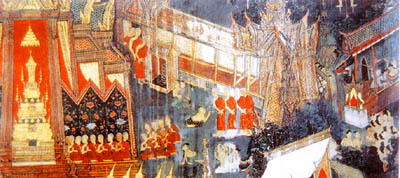|
| |
Painting
 Classical Thai painting was confined to temple and palace
interiors and book illustrations. Mural painting was developed to a high degree
in the belief that walls should enhance the beauty of the religious and royal
objects they surrounded. Classical Thai painting was confined to temple and palace
interiors and book illustrations. Mural painting was developed to a high degree
in the belief that walls should enhance the beauty of the religious and royal
objects they surrounded.
Traditional Thai painting was typically Asian in that conventional perspective
was ignored and figures were large or small depending on their importance.
Shadows were unknown and space was neutral rather than atmospheric. Figures were
two dimensional and lanscapes were merely sketchilytreated backdrops for
detailed action. A technique of pictorial composition called "apportioning areas"
was employed, comparable to the "bird's eye view" of Western painting. By this
method, the positions of the key scenes transformers" that effectively isolated
them from considerations of perspective by doing away with any surrounding
intermediate or middle ground.
The traditional Thai painter had five primary pigments, the close equivalents of
scarlet lake, yellow ochre, ultramarine blue, pipe-clay white, and pot-black,
With these he was able to produce as many other colors. All were tempura colors,
finely ground powders that were stirred into bowls containing a glue binder,
using sticks to work it to the desired strength and consistency. With these
colors the traditional artists created uniquely beautiful compositions in the
form of temple murals, cloth banners, and manuscripts illustrations.
The earliest surviving murals are characterized by earth colors made from
natural pigments. They depicted excerpts from the Jataka stories, episodes from
the Buddha's life, scenes of Buddhist heaven and hells, rows of gods, and scenes
of contemporary Thai life. The murals in Bangkok's Wat suthat and Thon Buri's
Wat Suwannaram are particularly fine examples.
The traditional painting technique continued into the Bangkok period, when
colors became richer thanks to pigments imported from China. Around the middle
of the 19th century, arthists began using chemical pigments and Western
perspective. Spatial values were eschewed for atmospheric effects, and opulent
gold leaf and bold primary colors radically altered the delicate harmony of the
old subdued earth colors.
Thai painters at present, though trained in the traditional style, have been
influenced by Western styles and techniques. However, some have been able to
integrate the various styles and produce significant art. Chakrapan Posayakrit,
for example, while best known for his portraits, is also a painter of scenes and
characters based on Thai literature which manage to convey a flavor that is at
once modern and traditional. Another well-known contemporary arthist is Thawan
Dachanee, who has experimented extensively within his medium.
|